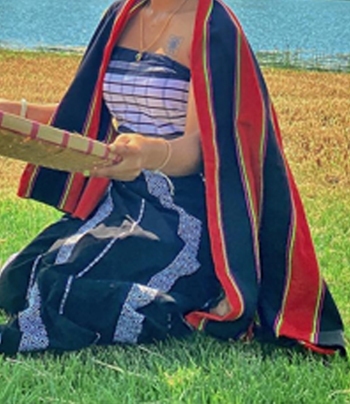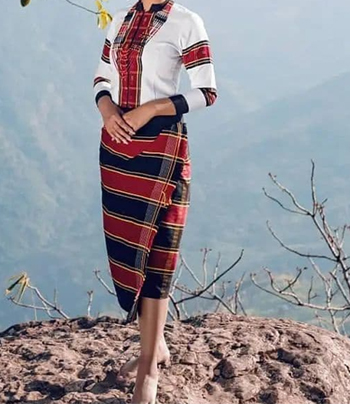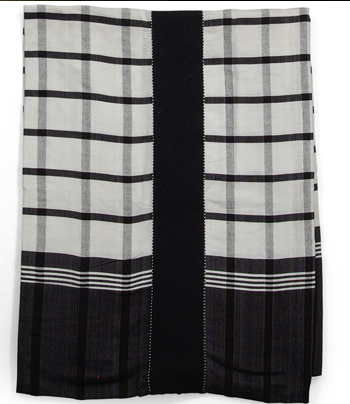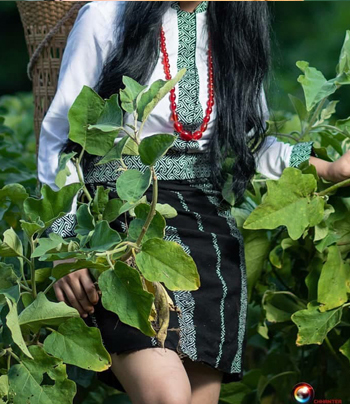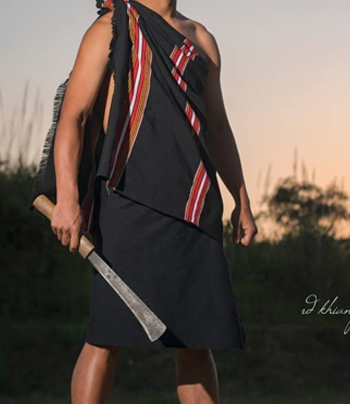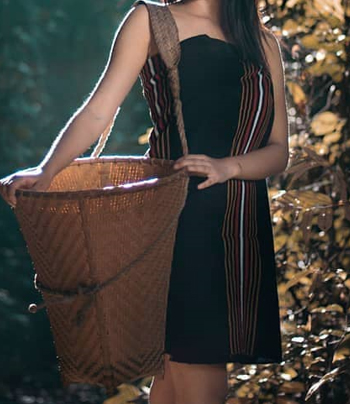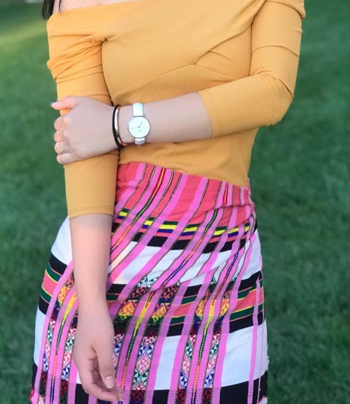Pawndum
Pawndum is a woven textile which is woven on a traditional loin loom (Puanbu). In olden days, homespun cotton yarns dyed with natural dyes are used for weaving. At present, synthetic yarns replaced the use of locally produced cotton yarns. In weaving these puans, the woof which crosses the multi-colored thread stretched artistically lengthwise as warp, consists of deep black thread. This has the effect of making the colored bars looked brilliantly deeper. As it is used as a shroud to cover dead body, it must be long enough to cover the body completely. Pawndum is rectangular in shape which is generally 65" in length and 45" in breadth, however the size could vary depending on the size of a person. awndum is an important traditional cloth of the Mizo people. Pawndum literally means black cloth. In Mizo language dum means
Ngotekherh
Ngotekherh is a traditional cloth (Handicraft) of the Mizo people. It is either draped or wrapped around the waist by women. It is a culturally significant textile/cloth of the Mizo people. Ngotekherh is a traditional puan highly prized by the Mizos. In the beginning this puan was popularly known as Puanhruih and it appears to have received this name from the word Hruih which in Mizo language means transverse stripes on cloth. The weaving of this stripes too was specially designed whereby the woof almost completely hid the warp from common view. In fact in the early days gradual development of puan-weaving such as speciality was looked upon as the great achievement in the weaving technique and their continued efforts to stabilize a distinctive design for this type of puan ultimately led to what it is today. This puan is also now known as Ngotekherh where the word Ngote in Mizo language refers to a pet name for a little boy or a girl and kherh is synonymous with hruih. It may not be unlikely that the name Puanhruih got gradually changed into Ngotekherh in view of its daintiness and newly evolved beauty in its design. The traditional color and design of the Ngotekherh has remained the same over the years, even though earlier Ngotekherhs were woven using mail spun cotton yarn and not acrylic. Even though Ngotekherh was traditionally woven using a blackstrap loom, now the majority of production of Ngotekherh is done using fly shuttle looms. It has also evolved in different color combinations such as red and white, and blue and white. Ngotekherh is a traditional cloth (Handicraft) of the Mizo people. Ngotekherh is a white base fabric with 7- 8 thick black warp borders on each side. These thick borders have five to six thin white stripes
Hmaram
Hmaram is a compactly woven textile. It is medium to heavy fabric and shows its good quality woven fabric. It is woven on a traditional loin loom. The weavers inserted the designs and motifs by using supplementary yarns while weaving. The different significant traditional designs and motifs are incorporated in this textile. A specially skilled weavers are required for making this elaborate textile. In the earlier days, homespun cotton yarns dyed with natural dyes are used. Synthetic yarns slowly replaced the use of locally produced cotton yarns, since wide range of synthetic yarns are available in the market. The weaving process of Hmaram involves starching of the warp yarns, warping, weaving, and inserting the designs and motifs by hand to make the complete Puan. Hmaram is very difficult to be woven. A white thread is used as the warp and a black thread as the weft. The cloth is weaved in such a way that it does not show any white colour except the pattern motifs. Since it requires a high level of expertise only an expert lady/ladies are able to weave such Hmaram cloth. The oldest patterned textile of the Lusei tribe, Hmaram is a single loom width fabric made from handspun soot/indigo-dyed and natural white cotton. It is worn as a short skirt wrapped around the waist, tucked in on one side. According to Mrs. Thankhumi, a scholar on Mizo textiles and a past weaver herself, the word ¡®Hmar¡¯ is a term used to describe hair buns at the back of the head. It could have been a name given to the Lusei tribe by the southern tribes since the southern tribes.
Tawlhohpuan
Amongst the Mizo Puan, Tawlhlohpuan has one of the most important cultural significance. Tawlhloh means to stand firm or to not move backward. The Tawlhlohpuan could only be worn by the most courageous warriors who had established a reputation for their bravery. The Mizo men wearing Tawlhlohpuan were expected to stand on their ground and to never retreat. In one Mizo folktake, a great warrior (Pasaltha in Mizo) named Darhnawka of Hualngo clan requested his wife to weave him a special cloth that was big enough to wrap his body if he died during a hunt or war. When Darhnawka wore the cloth, it meant that he was prepared to lay down his life and never retreat. The highest award offered for bravery/chivalry in the Mizo society is the draping of the Tawlhlohpuan. Therefore, Tawlhlohpuan holds high significance in the Mizo society. Tawlhlohpuan is produced throughout the state of Mizoram, and the main centre of production is at Aizawl and Thenzawl town.
MizoPuanchei
Mizo Puanchei is a compactly woven textile, it is medium to heavy fabric, and is a good quality woven fabric. It is woven on a traditional loin loom. The weavers inserted the designs and motifs by using supplementary yarns while weaving. The different significant traditional designs and motifs are incorporated in this textile. An especially skilled weavers are required for making this elaborate textile. In the earlier days, homespun cotton yarns dyed with natural dyes are used. Synthetic yarns slowly replaced the use of locally produced cotton yarns, since wide range of synthetic yarns are available in the market. The weaving process of Mizo Puanchei involves starching of the warp yarns, warping, weaving, inserting the designs and motifs by hand, and sewing together of the three pieces to make the complete Puan. A blouse called as Kawrchei is designed to match with Puanchei in which the design of Puanchei is seen at the centre front in a broad panel and at the sleeves.
Source: Intellectual Property India

